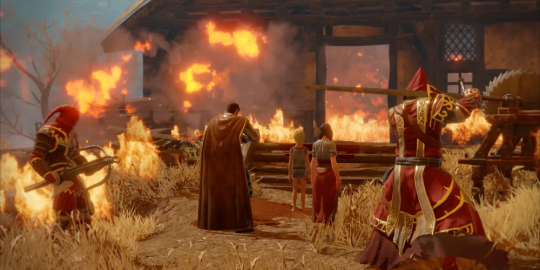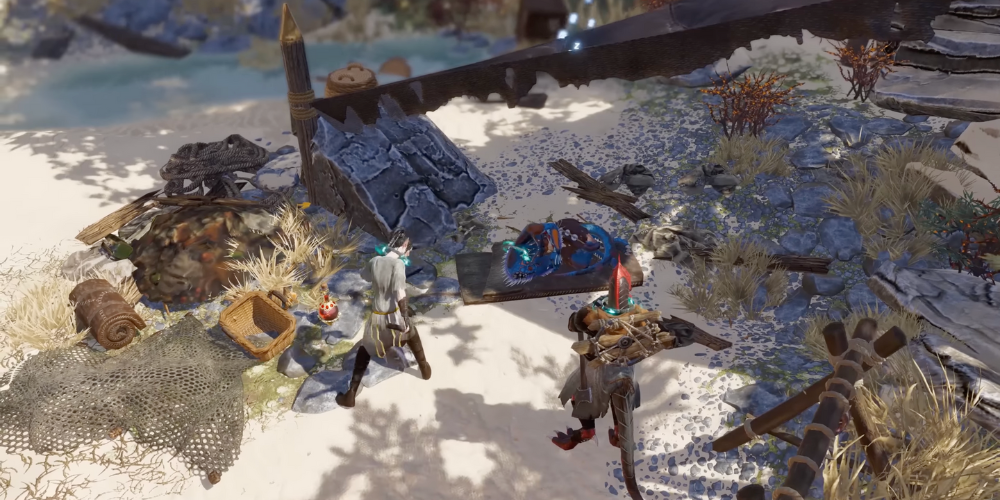
In the world of Divinity: Original Sin 2, strategy and tactical prowess elevate players from mere adventurers to legends. This in-depth exploration into the game's sophisticated warfare system reveals a vista of strategic possibilities, where every decision, no matter how minor, can subtly tilt the scales of victory or defeat. From managing elemental forces to crafting devious battle plans, understanding the art of war within Divinity: Original Sin 2 is essential for any player aspiring to conquer foes and unveil the rich narrative woven into its vast, interactive world.
Understanding the Elemental Dance
At the heart of warfare in Divinity: Original Sin 2 is the manipulation of the elements. The game world is a canvas for a complex tapestry of elemental interactions—fire spreads across oil, water conducts electricity, and poison gas explodes when ignited. Mastering these interactions isn't just a matter of powerful attacks; it's about controlling the battlefield. Players can create barriers of flame or electrify puddles to block paths, strategically shaping the flow of combat.
Advanced tactics involve combining spells for massive effects or using the environment to your advantage. For instance, casting Rain can douse flames and set the stage for a shocking Lightning Bolt. Learning the nuances of how elements interplay grants a significant upper hand, turning the tide of battle by manipulating the world itself as a weapon.
The Importance of Positioning
Positioning is crucial in Divinity: Original Sin 2. High ground offers increased damage and better range for attacks, turning an uphill battle in your favor. Conversely, engaging enemies from below can be perilous. Therefore, part of the pre-battle strategy often involves positioning your party strategically before engaging, ensuring ranged characters are safely perched above while tanks block chokepoints.

Stealth and invisibility can be used to reposition or prepare for a powerful opening assault. Abilities like Teleportation or Nether Swap further complicate positioning, allowing for rapid shifts in battlefield dynamics. Characters can be relocated into hazards for immediate damage, or enemies can be clumped together for area-of-effect spells. Astute positioning extends beyond simple geography; it's about manipulating every fight's spatial dynamics for maximum advantage.
Building a Balanced Team
A well-rounded team is the backbone of success. This involves more than just covering all the elemental bases; it requires a synergistic blend of abilities and roles. Tank characters should not only absorb damage but also control enemy movements with taunts and blocks. Mages, while frail, unleash devastating elemental combos and support the team with defensive spells. Archers and rogues offer crucial ranged and flanking damage, respectively.
However, flexibility within these roles is vital. A mage might need to switch from offense to healing, or a rogue may need to disengage from combat to revive a fallen comrade. Experimentation is key, and finding the right mix of abilities and talents for your play style can dramatically enhance your combat effectiveness.
Leveraging Tactical Retreats and Resurrections
Every battle doesn’t have to end with a clear victor. Sometimes, retreating to fight another day is a vital strategy. Tactical retreats can be used to regroup, heal, and reassess your approach. Skills that instantly move you across the battlefield are priceless for escaping dire situations or setting up strategic advantages.
Resurrection plays a key part in Divinity: Original Sin 2's warfare. Characters will fall in battle; however, rather than signify defeat, it opens strategic decisions regarding who, when, and where to resurrect. Using resurrection as a tactic, rather than a last resort, involves bringing back fallen allies in positions where they can immediately impact the battle—perhaps even turning defeat into victory.
Exploiting Status Effects and Crowd Control

Unleashing raw damage is often not enough. The clever application of status effects and crowd control can dismantle enemy forces with remarkable efficiency. Freezing, shocking, or petrifying key opponents neutralizes threats and reduces incoming damage. Meanwhile, effects like bleeding, burning, and poisoned chip away at health, slowly eroding the enemy's ability to sustain a prolonged fight.
Strategically applying these effects—considering the resistance and susceptibilities of your foes—requires foresight and planning. Combining crowd control with targeted damage against vulnerable opponents ensures that even the most formidable enemies can be overwhelmed by calculated precision.
Managing Resources and Cooldowns
Resource management extends beyond mere conservation of potions and scrolls; it encompasses the judicious use of skills and abilities. Every skill has a cooldown period, necessitating strategic planning to ensure that vital abilities are available when needed most. Balancing the use of powerful spells and attacks with their cooldown times is a delicate dance that can spell victory or defeat.
Equally important is the management of Action Points (AP), the currency of combat actions in Divinity: Original Sin 2. Every move, attack, or spell costs AP, and efficient use of these points is crucial. Maximizing damage, control, or movement within the limited AP budget each turn is an art form, requiring deep familiarity with your characters' abilities and potential synergies within the team.
Adapting to the Enemy
No single strategy guarantees success against all opponents. Enemy compositions and abilities vary widely, demanding flexibility in approach. Some foes may be immune to certain types of damage or effects, rendering standard tactics ineffective. Observing and adapting to these threats is crucial.

This might mean changing elemental attacks based on enemy weaknesses, prioritizing certain targets over others, or even adjusting your party's formation and strategy mid-fight. Adaptability extends to preparation as well—equipping the right gear, selecting appropriate abilities, and even choosing suitable consumables can provide the edge needed for victory.
Embracing the Unpredictable
The battlefield of Divinity: Original Sin 2 is fluid and ever-changing. Despite the best-laid plans, the chaos of combat often introduces unexpected variables. Environmental changes, sudden status effects, or even accidental self-sabotage (like igniting an oil slick you're standing in) can shift the momentum in an instant.
Embracing this unpredictability is key. Flexibility, the ability to rapidly reassess and adjust your tactics, can turn seeming disasters into opportunities. A spontaneous rain shower might douse your flames but also prepare the stage for devastating electrical assaults. Every unexpected twist is a chance to demonstrate tactical ingenuity.
Mastering the Art of War
The art of war in Divinity: Original Sin 2 is vast and intricate, offering a rich tapestry of strategic depth that rewards creativity, adaptability, and foresight. From elemental mastery to the careful orchestration of team dynamics, from the subtle nuance of position to the grand strategies of engagement—success in this game's battles is a multifaceted and rewarding challenge.
As players delve deeper into the complexities of combat, they'll discover that every encounter is a puzzle that wants to be solved, a challenge itching to be overcome. And with each victory comes not just progression but the satisfaction of having outsmarted and outmaneuvered foes in a truly cerebral confrontation. In the end, mastering the art of war in Divinity: Original Sin 2 is about weaving strategy, tactics, and resource management into a seamless whole, transforming battles into a dance of intellect, intuition, and ingenuity.